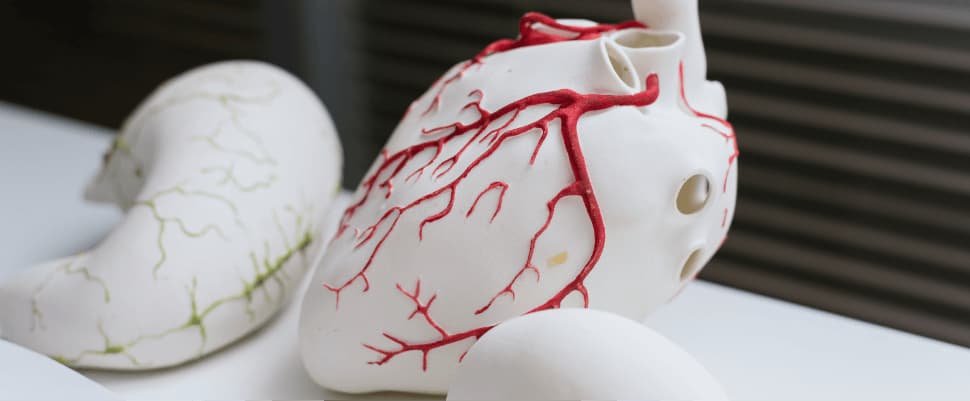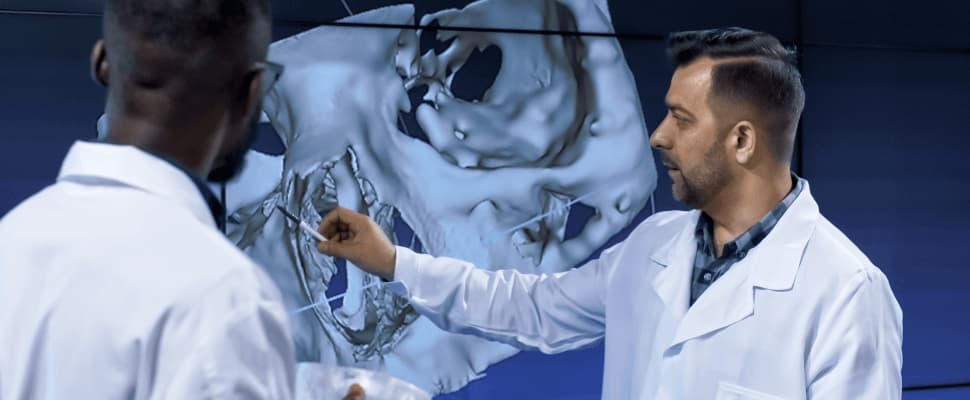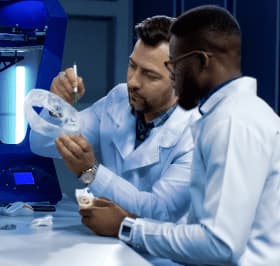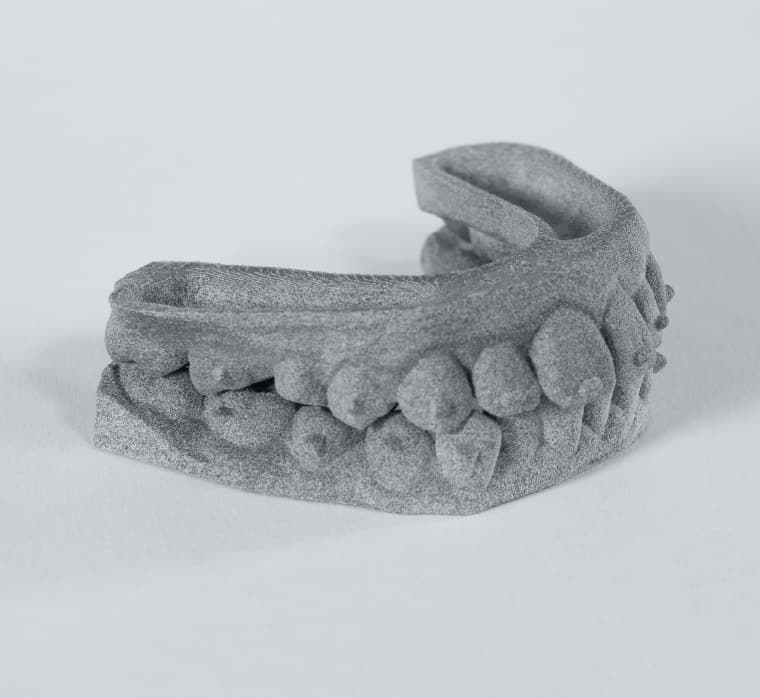How 3D printing changes healthcare quality
3D printing is one of the landmark technologies that keep pushing the boundaries of healthcare. Thanks to additive technologies, patients have prompt access to implants and prosthetics. They enable medics to practice on copies of human organs and prepare for surgeries. Discover how 3D printing is used in healthcare, and what MJF technology has to do with it.
3D printing in healthcare
Nowadays, you can build anything with a 3D printer: furniture, tools, enclosures, toys, and even houses. The technology has made its way into healthcare, too. Prosthetics, orthotics, implants, human organ models, orthopedic corsets, and teaching models—they all can be printed with additive technologies. But let’s take a closer look.
Dentistry. Dental medicine takes advantage of 3D printing the most often. Dentists 3D-scan their patients’ mouths and print perfectly adapted prostheses. Using a model of a patients’ jaw, dentists create veneers, crowns, and aligners. Patients thus don’t have to visit the dentist for adjustment as often if the dentist has a 3D-printed model of the patient’s jaw. Prosthodontic treatment has thus become less time-consuming and painful for the patient.
Orthopedics. 3D printing is popular in this field, too. For instance, the treatment of scoliosis in children often involves custom orthopedic corsets. With 3D printing, these can be made light, practical, and unnoticeable under clothes.

Implants. 3D printing is also helpful when custom-made body parts are needed, e.g., hip, knee, and shoulder joints. These require biocompatible materials (titanium, tantalum) and complicated, expensive printing technologies, e.g., direct metal laser melting. However, before an implant can be printed from metal, a prototype or master model needs to be made. For this, less expensive printing processes are used (FDM, MJF).
Prosthetics. Additive technologies have had a significant impact on prosthetics. Traditionally, to make lower-limb prostheses a plaster cast needs to be made. The prosthesis must be as comfortable and painless for the patient as possible, so it takes at least ten plaster casts to achieve adequate precision. The material takes a long time to cure, and then the cast needs to undergo finishing treatment. As a result, preparations alone can take over two workdays.
3D scanning and 3D printing can shorten the wait to just one day.
Prototypes. 3D printing technologies come in handy in creating human organ models. They are a great help to doctors that encounter rare diseases. In such cases, a model of the affected organ or object is printed. The prototype is then studied in the run-up to the surgery to improve the precision of operative treatment and lower the probability of medical errors.

Teaching models. Teaching models used by medical students can also be made by 3D printing. These are used to introduce interns to the specifics of human anatomy and provide means of studying a body part’s structure in detail. Previously, surgeons and students could only practice and study pathologies on real bodies, which were not always readily accessible. 3D printing can reproduce any part of the body with any known pathology.

High precision or speed of printing is not essential to building teaching models. In some cases, however, a series of highly detailed prototypes need to be made as fast as possible, e.g., a batch of corrective insoles or dental aligner molds. MJF would be a go-to technology in such cases. Let’s have a closer look at its advantages.
About MJF technology:
MJF (Multi Jet Fusion) — is a unique powder 3D printing technology from Hewlett Packard. During the build process, the industrial printer fuses PA 12 powder under the IR heat source. The material was developed especially for 3D printing applications. This printing technology and material make highly detailed builds with a smooth surface achievable. Besides, the finished items are resistant to moisture, UV rays, temperature, and mechanical stress.
How MJF technology is used in healthcare
MJF technology has opened new opportunities for individual therapy. For instance, it is used to build dental aligners, cranial helmets, and corrective insoles.
Cranial helmetsare used to treat head deformities in toddlers. The affected child wears the helmet 23 hours a day. The helmet fits tightly, shaping the child’s skull as it grows. In other words, the treatment adjusts the direction of growth, as opposed to restricting it.
It is crucial that they are made as lightweight and safe as possible. With MJF technology, breathable cranial helmets that cause less perspiration can be built with biocompatible polyamide PA 12, which doesn’t irritate skin or cause any other adverse effects in case of prolonged contact. Not only that but, the mesh-like design makes the helmet lighter, meaning it is comfortable to wear.
Orthotics. Children suffering from central paralysis need to wear ankle-foot orthoses. The joint is thus immobilized, giving more control over movement. The drawback of orthotics is that they are bulky and heavy.
With MJF printing, thin orthoses that easily fit into footwear can be built. They are durable and easy to put on and take off. The material also makes them suitable for regular washing or cleaning.

Corrective insoles. One of MJF technology’s applications is the printing of corrective insoles used in the treatment of flat feet and foot pain. These are also popular among athletes for improving the efficiency of training since they enable more controlled movement and stability. 3D printing is also a great option to build corrective insoles for formal shoes.
Corrective insoles are in high demand and hundreds of people turn to orthopedic clinics for them. It takes a production-grade printing line to make insoles in large batches. This is where MJF comes into play. With this technology, dozens of insole pairs can be printed in one cycle. The finished products are then cleaned up and sent off to the customer. The entire process takes 3–5 days at the most.
Dental aligners. Dental alignment usually relies on braces or brackets, but these cause physical and aesthetic discomfort to patients. Also, alignment with dental brackets involves regular visits to the dentist.
Dental aligners have become an innovative treatment in this field. These are mouthpieces that tightly fit on the teeth, applying pressure and thus gradually aligning them by a fraction of a millimeter.
The treatment may take from 3 to 18 months, during which the aligners are changed every two weeks—the entire treatment course may include 5 to 50 of them. Dental clinics may have hundreds of patients, each one requiring a custom set of aligners.

In each case, a model of the patient’s jaw is required. To create it, the doctors scan the patient’s mouth and then load the model into specialized software to adjust it. Then the model is built on a 3D printer and then used to make aligners.
An MJF printer can print hundreds of jaw models in one cycle, and it will take one day the most. Bearing in mind the cooling period, cleaning, and delivery, a clinic can get its order within 3–5 days.
MJF is an optimal printing technology for medical applications, where precision is critical. The building process is fast, and the resulting products are durable and resistant to UV rays, chemicals, and moisture. Not only that but, the polyamide used in printing is biocompatible and doesn’t cause any adverse effects on prolonged contact with the human body.


